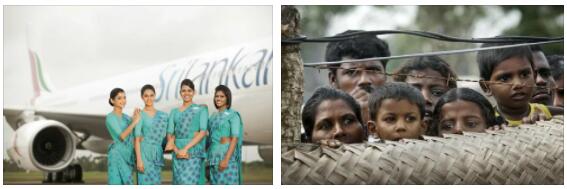According to Homeagerly, the official name of the state is Sri Lanka. On an area of 65,607 km 2 there were (March 1953) 8,103,648 residents distributed as in the table.
From an origin point of view there were, on the same date, 7,091,513 nationals (5,621,332 Sinhalese, 908,705 Tamil, 648,140 Moor, 28,736 Malays, 43,816 Burgher, 20,678 belonging to minor groups); 983,304 Indians; 5,749 Pakistanis; 6,909 Europeans; the rest of other nationalities. From the point of view of the religious denomination, the population appeared to be divided as follows: 5,217,143 Buddhists; 1,614,004 Hindus; 714,874 Christians; 541,812 Muslims; the rest followers of other confessions. The last census, in 1958, provides for the total population of the island the figure of 9,200,000 residents Among the cities with over 20,000 residents, in addition to those mentioned in the table, Dehiwala-Mount Lavinia (80,086); Kalutara (20,354); Kolonnawa (21,385); Kotte (53,862); Matara (27,697); Moratuwa (58,160); Negombo (38,591); Panadura (20,380).
Foreign trade. – The economic development possibilities of Ceylon have been carefully studied by a mission of the International Bank for Reconstruction and Development specially invited to the island by the local government. For the moment the main economic resource remains agriculture with a prevalence of products destined for export over consumption ones; in fact, of the 1.4 million ha of cultivated land, about 405,000 ha are coconut trees, about 240,000 ha are occupied by rubber trees, and about 225,000 ha are tea plantations. In the years 1951-1956, exports almost offset imports, both of them, hovering around 2 billion rupees per year with a slight difference in favor of the former. Although most of the cultivated area is occupied by coconut, the most exported product remains tea (for a value of 1,043,847,280 rupees in 1956); among the imported products the first place is held by rice (for a value of 263.689.483 rupees in 1956) followed by sugar (for a value of 95.723.541 rupees in 1956), cotton products (for a value of 86.944.806 rupees in 1956), etc. Commercial exchanges took place mainly with Great Britain and the nations of the Commonwealth, the USA, China, Japan and, occasionally, with some European or Mediterranean countries. In October 1957, a five-year economic agreement was entered into between Sri Lanka and the People’s Republic of China, with effect from January 1, 1958.
Under this agreement, Sri Lanka undertakes to sell 30,000 tons of rubber to the People’s Republic of China at normal market prices, and to buy 200,000 tons of rice in exchange. In 1959 the volume of trade between the two countries reached the figure of 124,600,000 rupees. The People’s Republic of China will also export textiles, coal, cement and foodstuffs to the island, and has undertaken the commitment to donate to Sri Lanka a textile factory worth 70 million rupees (equal to 5 million 250 thousand pounds).
The commercial activity of the port of Colombo (the largest on the island) has grown enormously since the economic plan that takes its name from Colombo became operative and which made the city perhaps the most important port of call in the south-eastern part of the continent. Asian.
History. – Having obtained independence within the British Commonwealth (February 4, 1948), the island had to face mainly internal settlement problems.
Of these the most serious was the linguistic one. Continuing the use of English as an official language would have meant not only impairing the acquired independence, but preventing the development of a modern national culture which is regarded as the best sanction and the surest guarantee of independence itself. The legislative provision, approved in June 1956, which makes Sinhala (about 6 million speakers according to data from 1953) the official language of Sri Lanka, also aroused the reactions of alloglot groups, especially that of Tamils, the most conspicuous of them for number (nearly 2 million including Indian Tamils) and cultural traditions, established mainly in the Eastern and Northern provinces. Violent clashes between Sinhalese and Tamils took place in the same June 1956 and, rejected by the government the proposal to create an administratively and linguistically autonomous Tamil state, again in May 1958. Although the legislative provision was not revoked, the most strenuous nationalists (also opposed to the adoption of modern Western systems in terms of medical therapy, etc..) did not hesitate to accuse the government of inability to defend Sinhalese interests. Proponent of this uncompromising nationalism was above all the Buddhist clergy whose heavy intervention in the political life of the island culminated in the assassination of the incumbent prime minister, Solomon Bandaranaike, perpetrated by a monk on September 25, 1958. W. Dahanayate was appointed prime minister, whose government was also forced to call new elections (20 July 1960) following which Mrs. Sirimavo RD Bandaranaike, widow of Solomon Bandaranaike, assumed the government. Although at the conference of Afro-Asian countries held in Bandung (Indonesia) in April 1955, C. sided with Iran and Pākistān, among the nations inclined to a policy of alliance with the West, its relations with the People’s Republic of China have remained good, as evidenced by the aforementioned trade agreements and the official visit to the island by the Chinese foreign minister Chou En-lai (31 January-5 February 1957).
Since January 1956 Sri Lanka is part of the UN. In January 1958 all public transport on the island was nationalized and in June of the same year the embarkation services of the port of Colombo with the creation of the Port (Cargo) Corporation. In the sphere of culture there has been a notable resumption of studies on the oldest history of the island, and of archaeological and epigraphic research (deciphering of the metric inscriptions of Sīgiri).
Finances. – The Central Bank of Ceylon went into operation in August 1950. In January 1952, the gold content of the rupee was established at 0.186621 grams of fine. The parity with the dollar is 4.76190 rupees to 1 US dollar.The ratio of 13.33 rupees to 1 pound has been kept unchanged since 1931.
